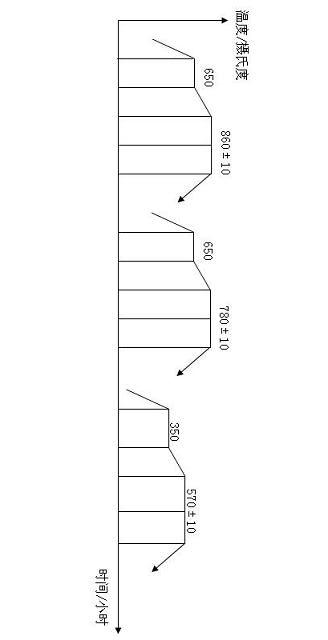Super-conventional performance heat treatment process for large axial forgings of carbon steel
A carbon steel and shaft technology, used in heat treatment furnaces, heat treatment equipment, manufacturing tools, etc., can solve the problem that the quenching intergranular precipitation and the refinement of grain size cannot be well controlled, and the impact toughness cannot be improved. The material cannot break through the bottleneck and other problems, and achieve the effect of grain refinement, high impact toughness, and structure improvement
- Summary
- Abstract
- Description
- Claims
- Application Information
AI Technical Summary
Problems solved by technology
Method used
Image
Examples
Embodiment Construction
[0013] Preferred embodiments of the present invention are described below, and it should be understood that the preferred embodiments described here are only used to illustrate and explain the present invention, and are not intended to limit the present invention.
[0014] The equipment used in this process is as follows:
[0015] (1) Forging heating and heat preservation: 800KW trolley-type resistance furnace;
[0016] (2) Hoisting of forgings: the main hook carries a 32T crane;
[0017] (3) Cooling of forgings: a water tank with a volume of 132 tons and a synthetic quenching liquid tank.
[0018] Such as figure 1 As shown, the heat treatment process of steel shaft forgings, the specific steps are as follows:
[0019] (1) Quenching treatment: heat up to 650°C according to the power, and after 3 hours of heat preservation, heat up to 860±10°C at a speed of ≤80°C / hour, and after 6 hours of uniform temperature, water cooling for 20 minutes and oil cooling for 30 minutes;
[...
PUM
 Login to View More
Login to View More Abstract
Description
Claims
Application Information
 Login to View More
Login to View More - R&D
- Intellectual Property
- Life Sciences
- Materials
- Tech Scout
- Unparalleled Data Quality
- Higher Quality Content
- 60% Fewer Hallucinations
Browse by: Latest US Patents, China's latest patents, Technical Efficacy Thesaurus, Application Domain, Technology Topic, Popular Technical Reports.
© 2025 PatSnap. All rights reserved.Legal|Privacy policy|Modern Slavery Act Transparency Statement|Sitemap|About US| Contact US: help@patsnap.com

